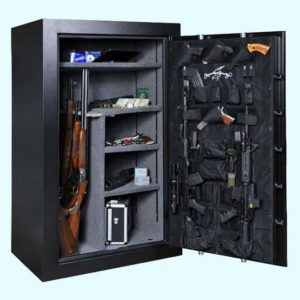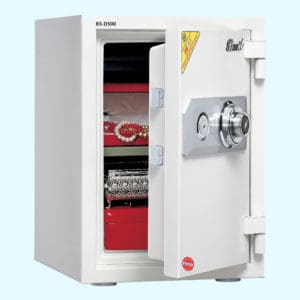When people buy safes, they are often surprised by the overwhelming selection that exists on the market. Safes come with an amazing array of features, and it isn’t always obvious which ones are important for a particular application. Even at a general level, there is a sizeable difference between gun safes, fire safes, jewelry safes and the rest. Figuring out what these differences are, and how they should guide a purchasing decision is a consumer’s primary directive. Fortunately, reputable security and safe providers can offer deep insight into the rich variety of available safes.
Be Selective
Real research is needed before buying a safe, whether it’s a gun safe, a jewelry safe, a fire safe or some other type of security container. This is an investment into, well, investments. That investment may be in the form of priceless jewelry, a collection of firearms, treasured family heirlooms or photos, or currency and important documents. No matter the asset, it deserves real protection, and this is where research comes in. Safes can be placed on a continuum of burglary protection and fire protection, and knowing where a particular safe falls on these continuums is key. How can a buyer do that? Consider what a safe should offer:
 Gun safes – Gun safes have to offer some level of fire protection, as should most safes. However, burglary protection is of paramount importance, as well as size. A common mistake among gun safe buyers is that they purchase a safe that they quickly grow out of. It’s much more cost effective to buy a slightly larger safe now instead of buying a second safe down the road. Again, though, burglary protection is essential, and the best way to check for this is by reviewing the safe’s Underwriters Laboratory (UL) rating. Underwriters Laboratories employ the best safe crackers in the world, so their ratings are considered the best available. The minimum level of burglary protection a buyer should consider is an RSC rating, which stands for Residential Security Container. To attain UL certification at RSC level or above, a safe must be constructed with a sufficiently thick steel body and door, as well as a high security locking mechanism. UL certification ramps up to UL TL-30×6, which refers to a safe that must resist a heavy tool attack from all sides for at least 30 minutes. This includes explosives and power saws. Not many burglars are going to be equipped with tools like that, so somewhere in the UL RSC, UL TL-15, UL TL-30 and UL TL-30×6 safes, there is one that will keep a set of firearms safe. Other considerations for gun safes are whether or not they are built with convenient racking and storage, and whether they come with an electronic or mechanical lock. Mechanical locks are the most reliable, but electronic locks offer quick access, which may be critical for home defense, so that’s an important consideration.
Gun safes – Gun safes have to offer some level of fire protection, as should most safes. However, burglary protection is of paramount importance, as well as size. A common mistake among gun safe buyers is that they purchase a safe that they quickly grow out of. It’s much more cost effective to buy a slightly larger safe now instead of buying a second safe down the road. Again, though, burglary protection is essential, and the best way to check for this is by reviewing the safe’s Underwriters Laboratory (UL) rating. Underwriters Laboratories employ the best safe crackers in the world, so their ratings are considered the best available. The minimum level of burglary protection a buyer should consider is an RSC rating, which stands for Residential Security Container. To attain UL certification at RSC level or above, a safe must be constructed with a sufficiently thick steel body and door, as well as a high security locking mechanism. UL certification ramps up to UL TL-30×6, which refers to a safe that must resist a heavy tool attack from all sides for at least 30 minutes. This includes explosives and power saws. Not many burglars are going to be equipped with tools like that, so somewhere in the UL RSC, UL TL-15, UL TL-30 and UL TL-30×6 safes, there is one that will keep a set of firearms safe. Other considerations for gun safes are whether or not they are built with convenient racking and storage, and whether they come with an electronic or mechanical lock. Mechanical locks are the most reliable, but electronic locks offer quick access, which may be critical for home defense, so that’s an important consideration. Jewelry safes / High Security safes – Jewelry safes should also offer strong burglary protection, as well as a nominal level of fire protection. UL ratings are, again, relevant here to selecting the proper jewelry safe. What should also be considered when buying a jewelry safe is how well organized its interior is.
Jewelry safes / High Security safes – Jewelry safes should also offer strong burglary protection, as well as a nominal level of fire protection. UL ratings are, again, relevant here to selecting the proper jewelry safe. What should also be considered when buying a jewelry safe is how well organized its interior is.
That’s why a lot of jewelry safes are built with padded drawers, so that like items can be kept together. Rings, bracelets, brooches, necklaces, earrings – a jewelry safe should be able to keep them all organized and protected from burglary and disaster.
 Fire safes – Like the name suggests, fire safes are for fire protection. Fire protection is something of a fuzzy term in the world of safes, as some manufacturers use their own tests to demonstrate fire defense, even though these tests are organized to produce the best possible results. If fire protection is a major priority when buying safes, then it’s best to pay attention to UL and Intertek’s Electrical Testing Lab (ETL) fire protection ratings. Both UL and ETL test safes by placing them in an oven that quickly ramps up to 1700 or 1850 degrees Fahrenheit, depending on the length of the test. A sensor inside the safe monitors interior temperature, and for the test to be considered a success, the temperature must never climb above 350 degrees Fahrenheit inside the safe. This is enough to protect most items, including paper, from harm. However, if something sensitive like data is to be stored, buyers should consider adding a fire drawer to their safe, as anything over 150 degrees Fahrenheit or so will be enough to destroy data. Fire safe ratings specify a time – usually 30 minutes, one hour or two hours. This refers to how long a safe can maintain the target interior temperature (350 degrees F) while in the midst of a typical building fire. Realistically, a house fire isn’t going to last very long, as fires sweep through buildings. Still, if critical items are being stored, then maxing out on fire protection is probably the best use of a budget.
Fire safes – Like the name suggests, fire safes are for fire protection. Fire protection is something of a fuzzy term in the world of safes, as some manufacturers use their own tests to demonstrate fire defense, even though these tests are organized to produce the best possible results. If fire protection is a major priority when buying safes, then it’s best to pay attention to UL and Intertek’s Electrical Testing Lab (ETL) fire protection ratings. Both UL and ETL test safes by placing them in an oven that quickly ramps up to 1700 or 1850 degrees Fahrenheit, depending on the length of the test. A sensor inside the safe monitors interior temperature, and for the test to be considered a success, the temperature must never climb above 350 degrees Fahrenheit inside the safe. This is enough to protect most items, including paper, from harm. However, if something sensitive like data is to be stored, buyers should consider adding a fire drawer to their safe, as anything over 150 degrees Fahrenheit or so will be enough to destroy data. Fire safe ratings specify a time – usually 30 minutes, one hour or two hours. This refers to how long a safe can maintain the target interior temperature (350 degrees F) while in the midst of a typical building fire. Realistically, a house fire isn’t going to last very long, as fires sweep through buildings. Still, if critical items are being stored, then maxing out on fire protection is probably the best use of a budget.
Using this information as a baseline, most consumers should have no trouble buying a safe that offers the needed level of fire and burglar protection. Pay attention to the ratings, ask the right questions and walk out with a safe that will do its job.
